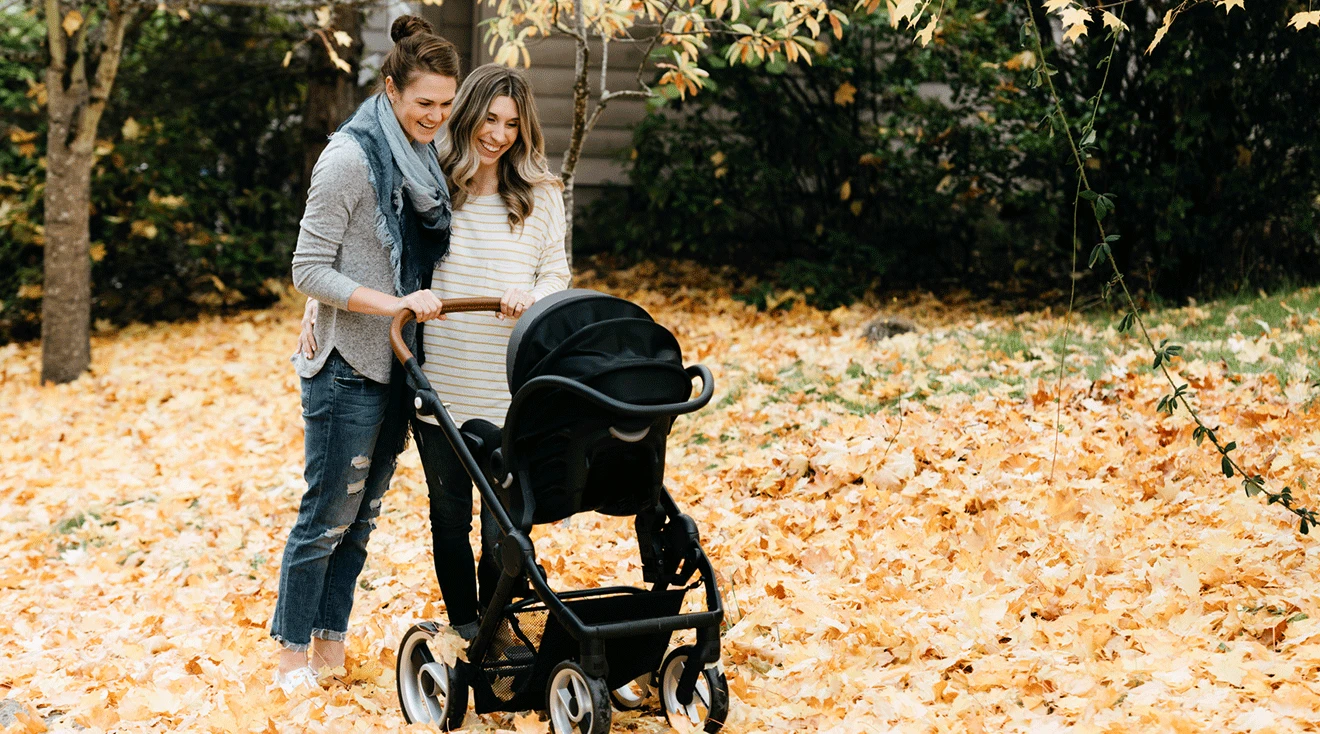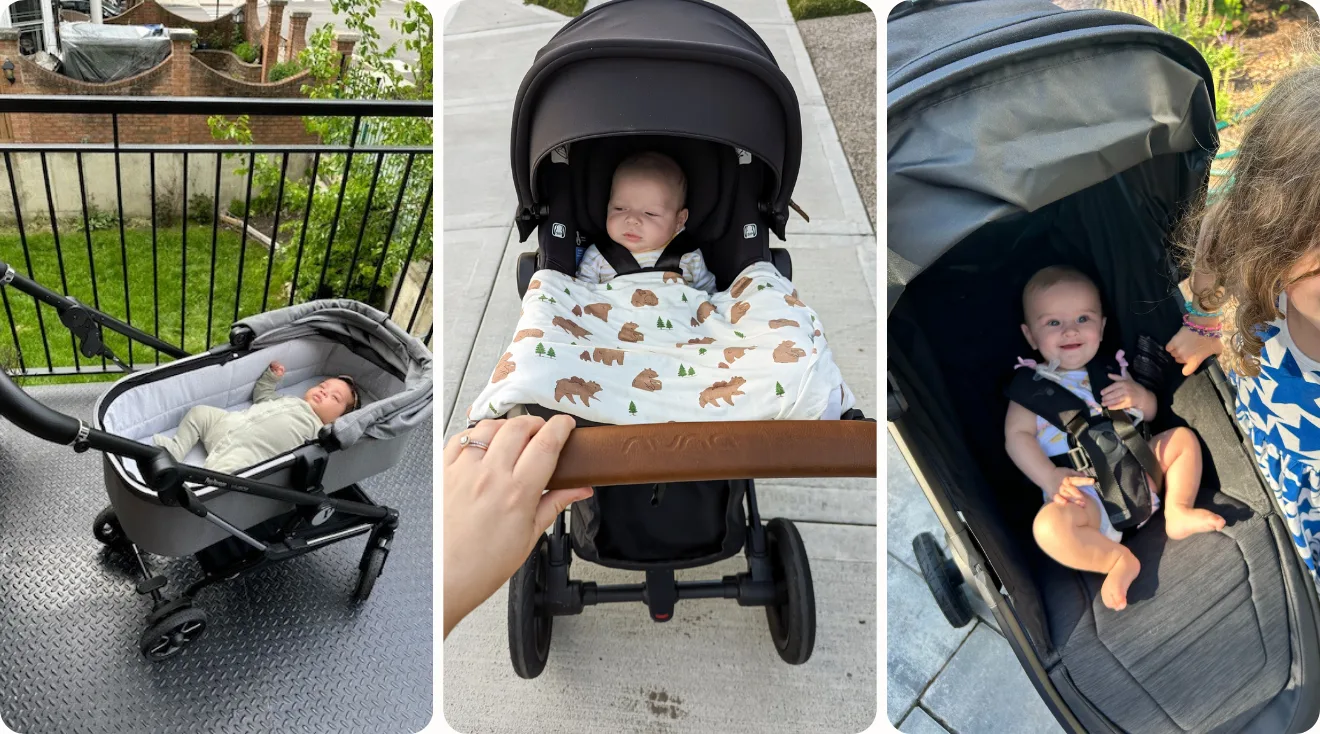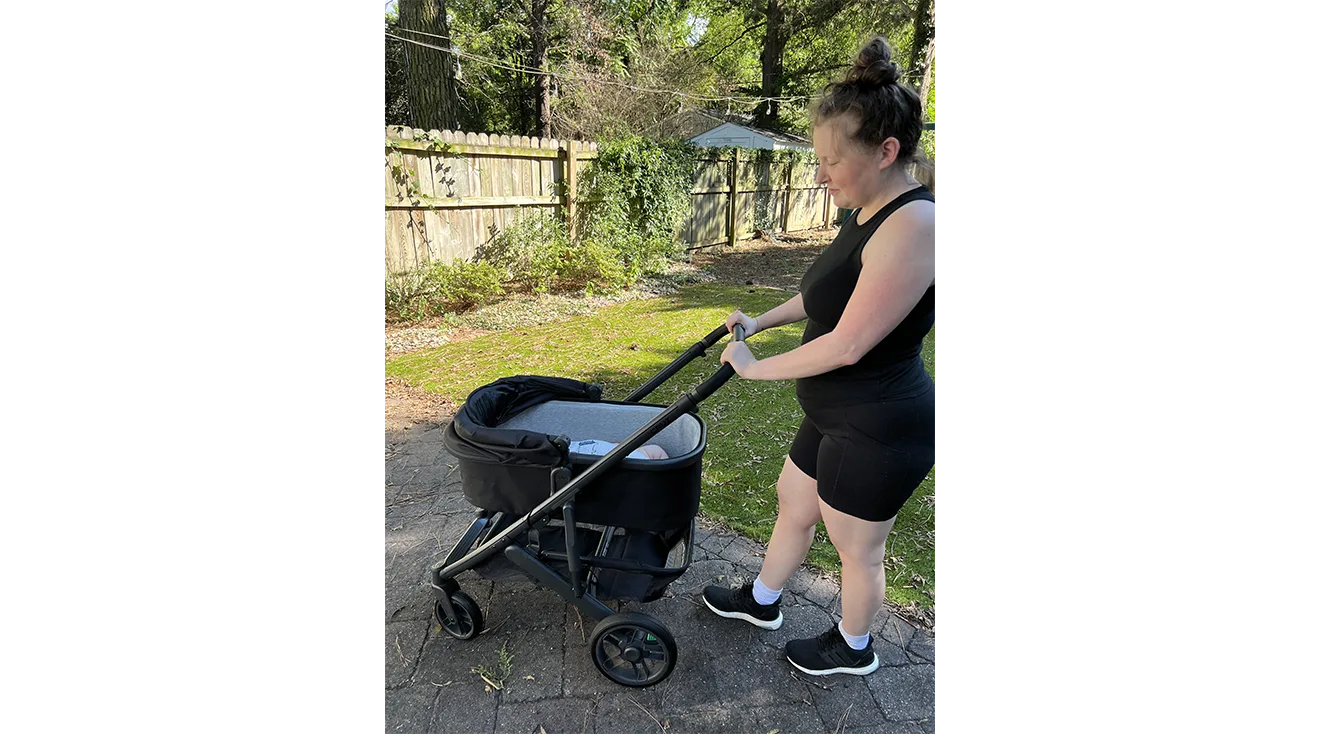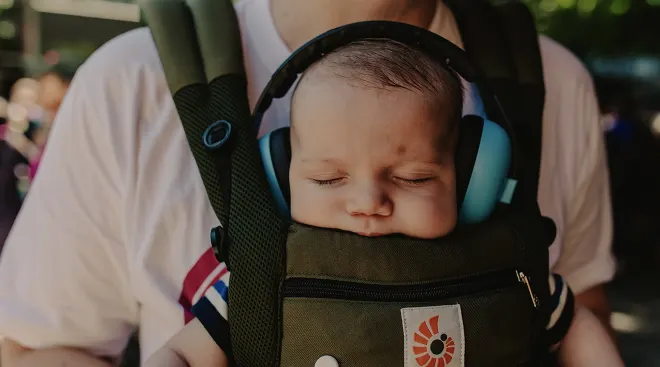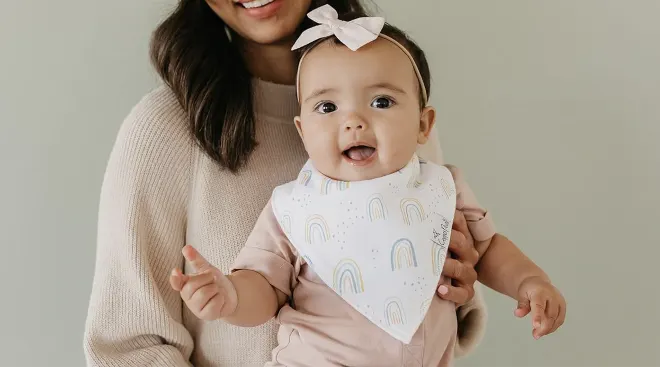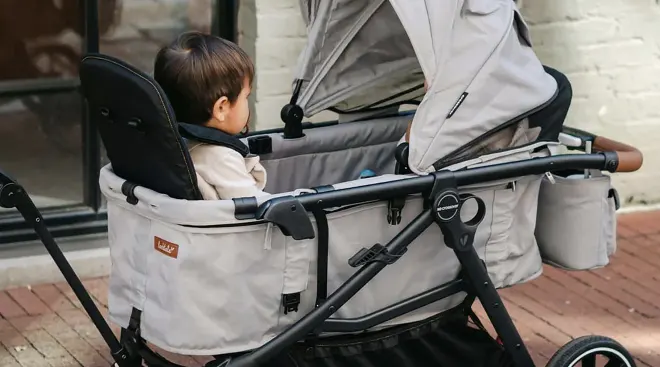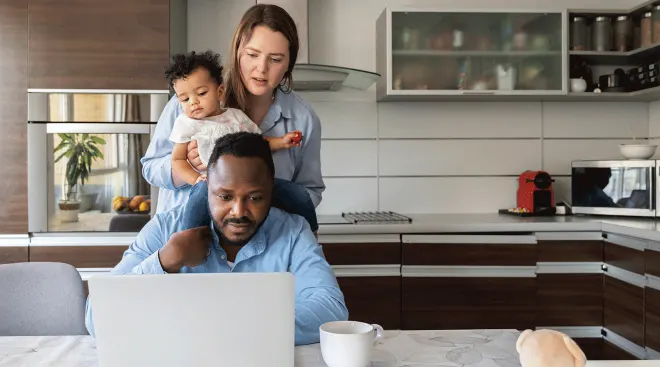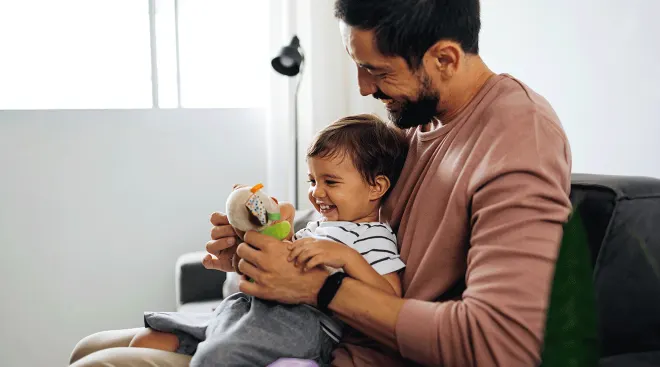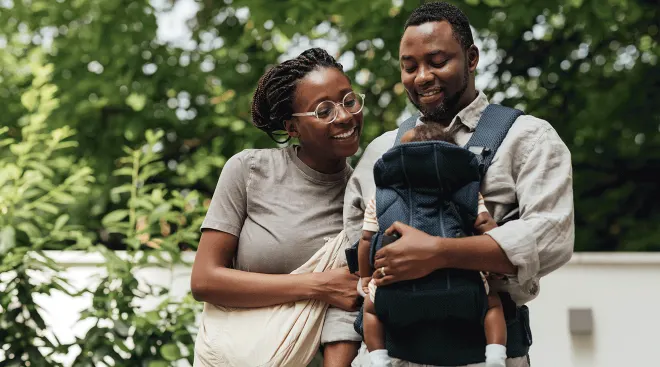The Best Strollers for Every Lifestyle, Tested by Parents
In a nutshell:
Based on feedback from our independent product testers and a survey of 300 parents from The Bump community, we chose the UPPAbaby Cruz V2 as the overall best full-size stroller. This model stood out for its impressive maneuvering for parents and roomy, comfortable seating for baby.
A new baby means a new set of wheels—so let’s talk strollers. When you’ve got a little one on the way, people are eager to tell you what you need to have on hand, from equipment to clothing and accessories. As a mom of four, I can tell you that while some of these things are more “nice to have” than they are “absolutely essential,” a full-size stroller is likely something you’ll use every day for years on end. With that in mind, it’s worth investing in a stroller that’s a piece of cake to use on a daily basis and will last as long as you need it to.
According to the American Academy of Pediatrics (AAP), the best strollers for infants have five-point harnesses, easy-to-operate brakes and wide bases to prevent tipping, among other safety details for a secure ride. But what other features should you keep an eye out for? Keep reading for advice on what to look for as you browse, plus our picks of the best strollers on the market today, including this year’s Best of The Bump winners, all of which have been tested by parents and their little ones.
If you’re looking for a stroller for a more specific need, like running, an upcoming vacation or for multiple children, read our separate articles where we’ve tested the best jogging strollers, best travel strollers or best double strollers.
The Bump editors conducted extensive research to identify 28 leading full-size strollers on the market, and chose a shortlist of the 16 best products to test. From there:
- We enlisted the help of 16 independent product testers to road-test more than a dozen models. These parents used the strollers with their own children and assessed the gear for ease of pushing and steering, folding and unfolding, ease of use, features, style and design, value for money and safety.
- We surveyed over 300 parents in The Bump community for additional insight into the pros and cons of top stroller brands and models.
- We followed guidelines from the AAP and the Consumer Product Safety Commission (CPSC) to better understand full-size stroller safety requirements.
- Because every family’s experience is different, we scoured forums and message boards and read user reviews to find out how these full-size strollers performed for parents across the country.
Editorial integrity is at the heart of everything we publish. Read about how The Bump develops and reviews all articles, including product reviews.
Overall best full-size stroller
- Pushes easily over a variety of terrain
- Handles tight turns well
- Large storage basket
- Parents say comfortably accommodates older toddlers
- Folding takes practice
- No cup holder or snack tray included
The UPPAbaby Cruz V2 is our Best of The Bump winner for the overall best full-size stroller due to its impressive comfortable features for babies and parents, and its standout performance across a variety of terrain. Our product tester Ivy awarded it a 10 out of 10 score for ease of pushing. “I've pushed it on uneven sidewalks and streets, grass, narrow paths, up and down curbs and crowded areas. It handles each one so so well,” she said. “It's clear the suspension is high-quality because of how easy it was to push along the bumpy, hard ground.” According to Ivy, this top-rated stroller also “turns like a dream; minimal effort is needed, even for sharp turns.” (See all of this year’s Best of The Bump winners.)
The Cruz V2 can be used from 3 months (or from birth with the infant insert or bassinet, both sold separately) up through toddlerhood and beyond—and it has a range of features to keep your child comfortable at any stage. A one-handed recline makes for easy napping, the reversible seat lets your little one face whichever direction they want, a roomy seat width and footrest easily accommodate older kids and the extendable and height-adjustable UPF 50+ canopy shades your kiddo at any age. “The hood is great. It covers half of the bassinet, with an extender that covers another 25 percent or so,” Ivy reported. “/[It offers] great coverage in the sun, but with a little side panel on the extender for baby to peek out of or us to peek in on him.” Our tester was also a major fan of the 30-pound capacity basket, which, in her words, “is absolutely HUGE and fits so so much, including an over-packed diaper bag from a new mom who thinks she needs too much stuff.”
Ivy rated the Cruz V2 another 10 out of 10 for ease of use, saying, “This stroller is incredibly user-friendly and intuitive, from assembly to usage.” She found the brakes simple to engage and the stroller “very easy to fold and unfold once you learn which buttons do what you need them to,” though she notes that it does require two hands. And while this pick is by no means a lightweight stroller, Ivy was able to comfortably lift it up over curbs and into her SUV trunk. Bottom line? While it comes with a hefty price tag, the Cruz V2’s high-quality construction, convenient features and impressive ability to handle a wide range of ground make it well worth it. As Ivy says, “I would absolutely recommend this stroller. The quality is hard to beat!”
Read our full review of UPPAbaby Cruz V2
Dimensions (open): 37.5″ (L) x 22.8″ (W) x 40″ (H) | Dimensions (folded with seat attached): 16.5″ (L) x 22.8″ (W) x 33″ (H) | Weight: 25.5 lbs. | Capacity: 50 lbs. | One-handed fold: No | Car-seat compatible: Yes | Converts to double: No | Stroller board accessory: Yes (sold separately)
Our product tester says:
“It can handle every single terrain we've tried (flat roads, uneven sidewalks, grass, gravel, dirt) and easily maneuvers up and down curbs or narrow paths. Every button and the brake require minimal effort to push or engage, and it's never been a hassle to adjust anything. It's obvious from the moment you take it out of the box that this stroller will last you for years, through the intense wear-and-tear kids will put it through.”
Our community says:
It's very easy to push, goes over rough terrain well and feels well made. – Evelyn*, mom of one and The Bump survey respondent
I like the ease of steering and the quality. It's worth its price. – Keelin*, mom of one and The Bump survey respondent
I ordered the Mesa after deciding to go with the Cruz stroller. I love that no adapter was needed and that it easily switched from front- to rear-facing positions. – JRT512, The Bump forum member
Best full-size stroller for newborns
- Newborn-friendly near-flat recline
- Very sturdy, according to our survey
- Easy to steer
- Good sun protection and ventilation
- Bulky when folded, according to our survey
- No one-handed fold
- No included cup holder
The Nuna MIXX Next has everything you want in a stroller for a newborn. Thanks to the newborn-friendly near-flat recline, it can be your family’s go-to set of wheels from the very beginning (without having to buy a pricey bassinet attachment). Our product tester Sarah, mom of a 2-month-old, found that it rolled seamlessly over both sidewalks and grassy fields, providing a smooth ride for her newborn even on bumpy terrain. Not only do you want to avoid jostling a new baby, but you also want to avoid sun exposure—and Sarah loved the MIXX’s water-repellent UPF 50+ canopy, especially because it has built-in ventilation panels “so baby can get good air circulation,” she said—an important feature for newborns who can’t yet regulate their body temperature. For added convenience, you can also buy the MIXX as a bundle with the PIPA RX car seat to form a complete travel system, so you can move from car to stroller (and vice versa) without taking your newborn out of their car seat.
Not only is it easy to push on a variety of terrain (earning it a 10 out of 10 score from our tester), but it’s equally as easy to turn. “I was really impressed with the stroller's maneuverability,” Sarah told us. “It's easy to steer one-handed, and the turn radius is fantastic.” The fold was easy enough for Sarah, though it can’t be done with one hand, and she appreciated the self-standing feature once folded.
And while looks are secondary to functionality, the Nuna MIXX definitely delivers in both areas, earning it another perfect score for style and design. “The stroller looks really modern and sleek in its design,” Sarah reported. “I like the ‘leatherette’ handles; they make the stroller feel really luxe.”
As a new or expectant parent, you’re likely focused on babyhood, but the Nuna MIXX can be used through the toddler years and into early childhood. As Sarah notes, “you'll get a lot of use out of this—quite possibly from birth until 4 or 5 years old.” It’s safe to say this versatile set of wheels, which clinched a Best of The Bump award for best newborn stroller, will be a staple for many future outings to come!
Read our full review of Nuna MIXX Next stroller
Dimensions (open): 32.7" (L) x 23.6" (W) x 45.3" (H) | Dimensions (folded): 27.5" (L) x 23.6" (W) x 19" (H) | Weight: 28.3 lbs. | Capacity: 50 lbs. | One-handed fold: No | Car-seat compatible: Yes | Converts to a double: No | Stroller board accessory: No
Our product tester says:
“The two features I love most about the stroller are the full recline for babies under 6 months of age and the fact that you can face the seat either way. The suspension is also really good and helped make it a pretty smooth ride for my baby even on bumpy terrain. ”
Our community says:
It's easy to fold, feels sturdy, offers great sun coverage and has great style [and] design. – Steph*, mom of one and The Bump survey respondent
I love that our infant seat (Nuna Pipa) clicked right in—super easy. It’s very easy to get up and down, switch the seat from front-facing to back-facing, etc. [It’s] very easy to push [and] comfy for my son. I’ve loved everything about it. – chicandbubbly, The Bump forum member
Best full-size stroller for country life
- Large tires and excellent suspension
- Smooth off-road pushing
- Easy maneuverability and tight turn radius
- One-handed fold
- Air-filled tires can lead to punctures
If you live in the countryside, you’ll want a stroller that can handle rugged terrain, fold up quickly to be stashed in a car trunk and clean up easily. The Thule Urban Glide 4-wheel—our Best of The Bump winner for best stroller for country life—checks all of these boxes and then some. Kayla, our country-dwelling product tester, gave this stroller high marks for its large air-filled rear wheels—at 16-inches, by far the largest of any stroller we tested—which allowed for smooth off-road pushing. “Despite its lightweight design, it felt sturdy and balanced, making it easy to push even with additional bags in the basket,” she shared. “On bumpy ground, the stroller's suspension and tires absorbed shocks effectively, ensuring a smooth ride for my baby without any discomfort.”
The Thule Urban Glide 4-wheel has an intuitive folding and unfolding mechanism, which Kayla described as a “game-changer.” According to her, “I could fold it effortlessly, even while holding my baby with one hand.” When on the go, she also appreciated that the folded stroller didn’t take up too much room in the trunk of her car despite being a robust off-roader.
She also praised this stroller’s ease of use, giving it a full 10 out of 10. “Setting up the stroller from the box was a breeze and took me around five minutes,” Kayla reported. “It was just a few pieces and—BAM!—it was all set up.” After taking it for test spins, she also noted the well-placed, easily engaged handbrake that gives greater control on rough ground, the telescoping handlebar and easily adjustable seat. The basket (with a 22-pound capacity) was convenient and well-sized, just like everything else about this set of wheels. "The size of the stroller felt just right, striking a balance that made it manageable for daily use without feeling too bulky or cumbersome,” Kayla praised. “The stroller exceeded my expectations in terms of durability, functionality and comfort.”
Dimensions (open): 27.3″ (L) x 34.8″ (W) x 45.8″ (H) | Dimensions (folded): 22.8″ (L) x 34.8″ (W) x 11″ (H) | Weight: 28.7 lbs. | Capacity: 49 lbs. | One-handed fold: Yes | Car-seat compatible: Yes | Converts to a double: No | Stroller board accessory: No
Our product tester says:
“The stroller was an absolute delight in terms of ease of pushing and steering. I took it on various terrains, including smooth pavements, grassy parks and rugged paths during outdoor adventures. It handled all these terrains effortlessly. When transitioning from flat ground to uneven surfaces, such as gravel or cobblestones, the stroller maintained its smooth maneuverability, providing a stable and comfortable ride for my baby. ”
Our community says:
Great aerodynamics; good storage and quality. – Meike*, mom of one and The Bump survey respondent
I love it! We're active people, and the stroller didn't disappoint, even in the sand or the snow! It's very lightweight, [can] fold with one hand, and the wheels can be removed easily for storage. – danjoly, The Bump forum member
Best full-size stroller for city life
- Easy to push on pavements and make tight turns
- Compact fold for easy storage
- Lightweight
- Easy-to-access basket
- Not good on uneven terrain
- Folding mechanism has a learning curve
As an urban family you’ll want a stroller that’s sturdy enough to handle curbs and sidewalks, yet light enough to lift up steps. It should also easily maneuver around tight corners and through crowded areas and narrow spaces. Thankfully, the Peg Perego Vivace Stroller, our Best of The Bump winner for best stroller for city life, is up for the challenge. “The stroller is lightweight, even when pushing it,” our tester Erin reported. “It has that gliding feeling when you’re on smooth terrain.” This smoothness can be attributed to the soft-ride wheels, complete with rear shock absorbers, and the swivel front wheels which work together to ensure agility. “It’s so easy to maneuver around things and is a very smooth, easy drive,” Eric said. Even better, this stroller weighs just over 20 pounds, making it the lightest option on our list—great for hoisting up onto public transit.
Testing revealed that this isn’t the best option for parents who plan to use their stroller on grassy terrain—the small wheels that make the Vivace so well-suited for smooth pavement don’t handle countryside well—but it practically flew on sidewalks and in stores. (“I took it for a stroll through Target, and it was great!” Erin gushed.)
The easy fold and unfold really stood out for Erin. Scoring it a 10 out of 10 in this category, she told us it was “my absolute favorite part about this stroller by far!” While it technically offers one-handed folding, she said it was still easier to do with two, but either way, she was thoroughly impressed. “It folds up so smoothly and [is] extremely compact for a stroller this size when unfolded,” she reported. “I could carry it and walk through doorways easily.” She found that the stroller was easy to tuck into the trunk of her car. Plus, “it fits so easily into the nook of our closet, and I loved that so much—that alone makes it worth it because it's easy to store away when not in use.” As a result, it’s ideal for families who live in apartments or don’t have a lot of extra storage space.
The Peg Perego Vivace is also packed with plenty of details you and your little love will appreciate on a daily basis. The hood (which has a mesh peephole to peek at baby) provided plenty of coverage and expanded with the help of a zipper as needed. The roomy basket was able to accommodate a regular-sized diaper bag too. “Because it was so open, it made for easy access,” Erin mentioned. What’s more, the seat adjusts from 90 degrees to a near-flat recline, a nice perk for when sleepytime hits during outings.
Setting up the stroller and its additional attachments (like the bassinet) took about 40 minutes for Erin, who found that the manual “wasn’t self-explanatory.” However, after watching a few instructional videos, it was smooth sailing from then on. All in all, Erin concluded that this stroller is a great fit for city life, thanks to its compact, lightweight size and standout maneuverability. “I would recommend this stroller to a friend who lives in the city or in a neighborhood they planned to walk around in,” she told us.
Dimensions (open): 27.5" (L) x 20" (W) x 41" (H) | Dimensions (folded): 15" (L) x 20" (W) x 28" (H) | Weight: 20.7 lbs. | Capacity: 50 lbs. | One-handed fold: Yes | Car-seat compatible: Yes | Converts to a double: No | Stroller board accessory: Yes (sold separately)
Our product tester says:
“The compactness of it did kind of take my breath away! I was so impressed at how it was so easy to fold and unfold. /[Being able to] store it away in a closet was huge. …For a city, grocery store and even-terrain strolls, it works great! Also goes through doorways great!”
Best budget-friendly full-size stroller
- Value for money
- Smooth pushing
- Easy to fold and transport, according to our survey
- Near-flat recline
- Small storage basket
- Belly bar and cup holder bought separately
- Brake is tricky in recline setting
Searching for a quality set of wheels that won’t break the bank? You can’t go wrong with the Baby Jogger City Mini GT2, our Best of The Bump winner for best budget-friendly stroller. It offers many of the same features you find on top-performing models, for hundreds of dollars less. Thanks to several baby-friendly features, like a near-flat recline and a magnetic peekaboo window in the full-coverage sun canopy, the City Mini GT2 can be used right from birth (without buying additional attachments), so you can truly get the most bang for your buck. Our product tester Jaclyn particularly appreciated the recline, which she found useful for her little one’s midday snoozes. “It goes nearly flat, which is great when my baby decides to nap on the walk,” she told us. “I was even able to adjust the recline without waking her up!” She also found it a breeze to maneuver, awarding it a 10 out of 10 for ease of pushing. “I love that this stroller can be used on a variety of terrains; it was easy to maneuver through a busy farmer’s market,” she praised.
Parents tend to have a lot on their hands—which is why we love full-size strollers like this one that offer a one-hand fold. “I can easily fold this one-handed while holding my baby. I put it to the grandparent test, and they were also able to fold and carry this stroller folded with no trouble at all,” Jaclyn shared. “It’s very easy to put in and take out of the car and set up.” She gave the City Mini GT2 10 out of 10 scores for folding and unfolding, as well as style and design. “Cleaning this stroller is also quite easy, and the fabric is very durable yet comfortable,” she explained.
While this affordable baby stroller has most of the features you’d find on more expensive models, it’s missing a few details that Jaclyn would have liked to see. This includes the belly bar and parent cup holder, which have to be purchased separately. She also pointed out that the brake can be difficult to use while the stroller is in a recline position. But at the end of the day, this top-rated stroller impressed Jaclyn with its smooth ride, easy one-handed fold and high weight limit, which she said will “make it functional for my family for many years.”
Dimensions (open): 46.8" (L) x 24.2" (W) x 43.5" (H) | Dimensions (folded): 24.2" (L) x 10.2" (W) x 29.5" (H) | Weight: 22.4 lbs. | Weight capacity: 65 lbs. | One-handed fold: Yes | Car-seat compatible: Yes | Converts into double: No | Stroller board accessory: Yes (sold separately)
Our product tester says:
“This is an exceptionally smooth riding stroller and is reasonably priced for the quality. I absolutely think it’s worth it.”
Best full-size stroller that will grow with your family
- Quality at a competitive price
- Multiple configurations work well for baby and toddler
- Easy to maneuver, even as a double
- Convenient one-handed fold
- Bulky fold
Whether you’re thinking of expanding your family in the future or already have a growing family, the Mockingbird Single-to-Double 2.0 Stroller is a great model that provides room for everyone. This stroller comes as a single but has add-ons that snap in easily to accommodate an additional newborn, toddler or pre-schooler. But the real standout is the stroller’s competitive price in the single-to-double market without compromising on quality and performance. “It looks like a luxury stroller and offers all the features as such, but for a much more reasonable price,” enthused our tester Michelle.
A recent upgrade to the original Mockingbird, the 2.0 has improved suspension andMichelle awarded this stroller a 10 out of 10 for ease of pushing, citing that its maneuverability is “unimaginably smooth” and the stroller “glides effortlessly.” This was the case even when being pushed with just one hand—and even with the large basket ladened with stuff. “/[The basket] holds anything you could want or need without affecting the steering,” she raved. Even in the double stroller mode, which is typically harder to push, the Mockingbird “is easy to navigate and maneuver in tight spaces, in stores and through all terrain areas.”
When it comes to folding, the ability to do so one-handed is “wonderful” and quick to learn. “As a single, the stroller folds down to a reasonable size and could fit in most trunks,” Michelle told us, but noted that when folded in double mode, it’s a bit bulkier. As a workaround, she recommends removing the seats before placing the stroller in a vehicle for straightforward storage.
Testing revealed this baby stroller is very easy to set up, too. “The bassinet and seats can be removed with the push of a button, which is very convenient,” Michelle praised. The seats also recline easily with the help of a lever in the back. “My 2-year-old was able to comfortably take a nap with the multiple recline options offered,” she said.
Our takeaway: The Mockingbird is easy to assemble, easy to push, easy to fold and easy on your wallet. “It’s very similar to many luxury strollers on the market but at a much more reasonable price point,” Michelle pointed out, making it a winner in our books.
Dimensions (open): 33" (L) x 25.5" (W) x 40" (H) | Dimensions (folded): 18" (L) x 25.5" (W) x 34" (H) | Weight: 26.5 lbs. | Capacity: 50 lbs. | One-handed fold: Yes | Car-seat compatible: Yes | Converts to double: Yes | Stroller board accessory: Yes (sold separately)
Our product tester says:
“The many configurations available for double mode make it so easy to keep all the kids comfortable on the go. The seats have ample cushioning, and my infant was happy both parent- and outward-facing. My toddler had enough room parent-facing and loved being able to interact with the baby.”
Our community says:
I really love my Mockingbird stroller. […] It was important to me that I buy one that could adapt to a double stroller (they also have a single only) since we were pretty sure we would try for a second. – curlyandpreggo, The Bump forum member
*Note: Some names have been changed due to privacy requests.
Full-Size Strollers Comparison Chart
| Overall best full-size stroller | Best full-size stroller for newborns | Best full-size stroller for country life | Best full-size stroller for city life | Best budget-friendly full-size stroller | Best full-size stroller that will grow with your family | |
|---|---|---|---|---|---|---|
Overall Best 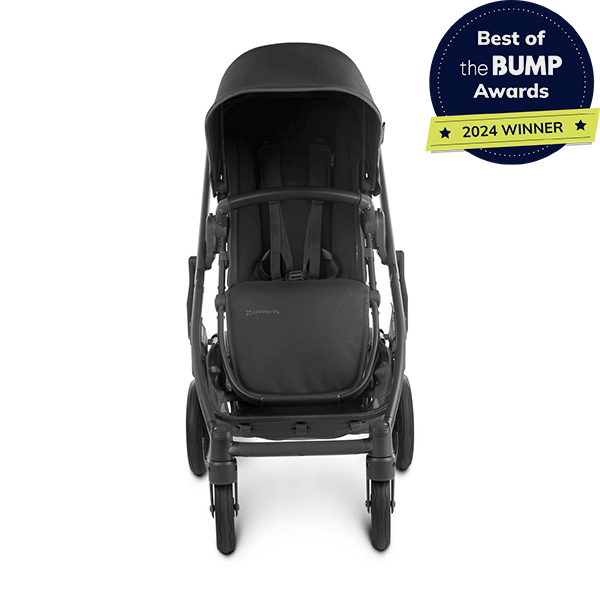 UPPAbaby Cruz V2 Stroller | 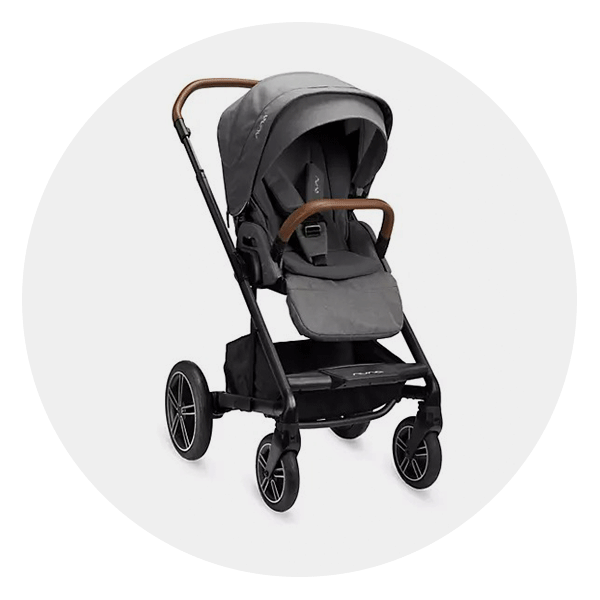 Nuna MIXX Next Stroller | 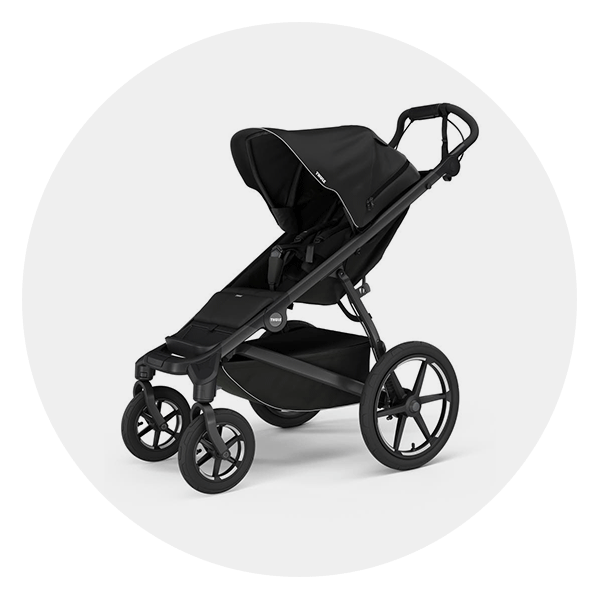 Thule Urban Glide 4-wheel | 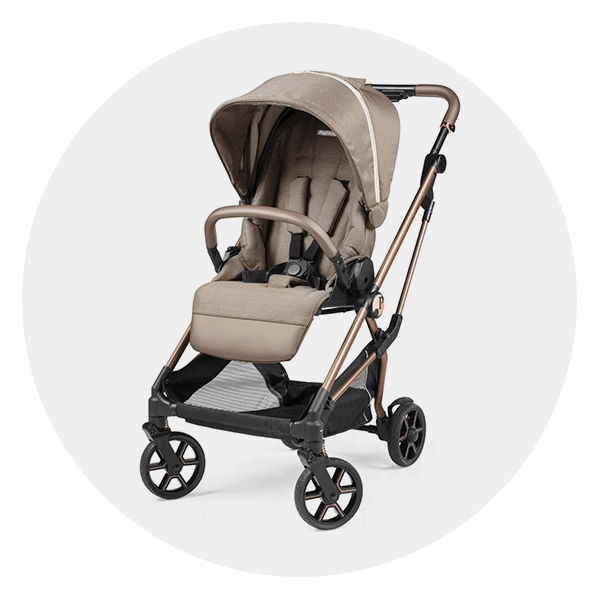 Peg Perego Vivace Stroller |  Baby Jogger City Mini GT2 Stroller | 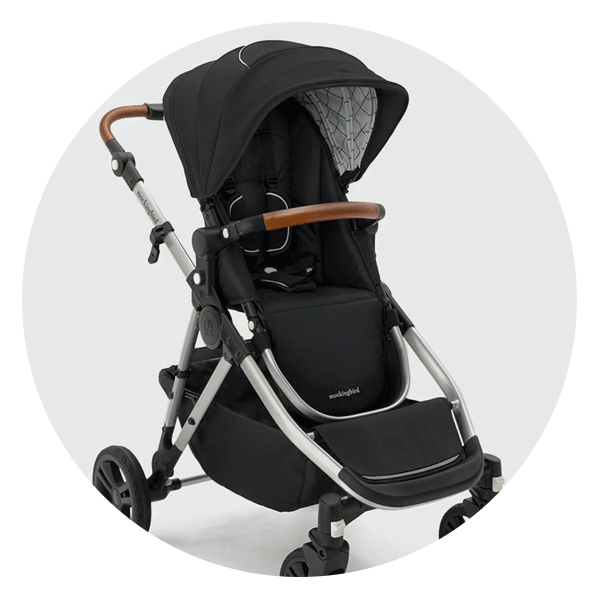 Mockingbird Single-to-Double 2.0 Stroller | |
| Price | $$ | $$$ | $$ | $$ | $ | $ |
| Folded dimensions | 16.5″ (L) x 22.8″ (W) x 33″ (H) | 27.5" (L) x 23.6" (W) x 19" (H) | 22.8″ (L) x 34.8″ (W) x 11″ (H) | 15" (L) x 20" (W) x 28" (H) | 24.2" (L) x 10.2" (W) x 29.5" (H) | 18" (L) x 25.5" (W) x 34" (H) |
| Open dimensions | 37.5″ (L) x 22.8″ (W) x 40″ (H) | 32.7" (L) x 23.6" (W) x 45.3" (H) | 27.3″ (L) x 34.8″ (W) x 45.8″ (H) | 27.5" (L) x 20" (W) x 41" (H) | 46.8" (L) x 24.2" (W) x 43.5" (H) | 33" (L) x 25.5" (W) x 40" (H) |
| Weight | 25.5 lbs. | 28.3 lbs. | 28.7 lbs. | 20.7 lbs. | 22.4 lbs. | 26.5 lbs. |
| Can be converted to double | ||||||
| One-handed fold | ||||||
| Car seat compatible | ||||||
| Basket capacity | 30 lbs. | 10 lbs. | 22 lbs. | 15.4 lbs. | 30 lbs. | 25 lbs. |
| LIe-flat recline | ||||||
| Buy NowRead Full Review | Buy NowRead Full Review | Buy NowRead Full Review | Buy NowRead Full Review | Buy NowRead Full Review | Buy NowRead Full Review |
The Bump is thrilled to partner with Consumer Reports to highlight its in-depth product information and recommendations. Together with one of the most respected nonprofit organizations in research, testing and advocacy, we’re offering key insights about products you can trust for your growing family. Join now to unlock 100+ car seat ratings and reviews!
Wondering what type of stroller will work best for your family? That depends on several key factors. Think about how many children you need to transport (and their ages), where you expect to use the stroller most of the time, how much room you have to store the stroller and, of course, your budget. All of these will figure into your choice. Every family is different, and what works for one may not be right for another.
Consider how often you travel, if you’ll be using public transportation regularly (subway stairs are something to consider if you live in the city), who will be using the stroller (grandparents may especially appreciate a stroller that’s easy to unfold and buckle baby into) and what accessories are available for your preferred stroller.
Stroller usability
Testing strollers in person can be helpful to give you a feel for the handling, maneuverability and ease of folding and unfolding (which isn’t always as intuitive as you might think). If you try a stroller out, consider these questions:
- How easy is it for me to push, pull and pivot?
- If multiple caregivers will be using it, does the handlebar adjust for different heights?
- Is there a storage basket, and how large and accessible is it?
- What are the steps for folding and unfolding? Do any parts need to be removed to collapse the stroller?
- Will this fit in my trunk or storage space?
- Where is the brake, and how easy is it for me to engage?
- How well does the seat recline for convenient naps on the go?
- What type of accessories are available?
Stroller safety features
All strollers sold in the US are strictly regulated by the CPSC to ensure they meet the highest safety standards. That said, you’ll also want to look for these extra safety features when choosing a stroller:
-
Easy-to-operate brakes. Anytime you stop walking, the stroller brakes should be activated, so make sure you have easy access. According to the AAP, brakes that lock both wheels rather than just one provide an extra measure of safety.
-
Safety harness. A five-point safety harness is the gold standard when it comes to strollers. This type of harness safely restrains your child at the shoulders and hips for added security while you roll.
Frequently Asked Questions
How many strollers do I need?
How many strollers you need largely depends on your lifestyle, preferences and budget. You’re going to need at least one stroller to get you and baby from point A to point B seamlessly on a daily basis—but the type you go for is up to you. A full-size stroller, a car seat/stroller combo, a compact stroller or even an umbrella stroller could serve this purpose. That being said, many families also invest in a specialty stroller. This could be a jogging stroller, a wagon stroller, a travel stroller or anything else that meets your family’s needs.
Can I buy a used stroller?
Buying used baby gear can be a great option for families on a budget—but be sure you know what to look for to ensure your little one is as safe as can be. When it comes to strollers, you’ll want to inspect each model thoroughly before purchasing. In particular, you’ll want to double-check that its wheels, brakes, straps and seat recline features are all functional. Last but definitely not least, do some research on the CPSC website or at Recalls.gov to see if it’s been recalled at any point and to make sure it complies with the latest stroller safety requirements.
Can baby sleep in a stroller?
If your stroller has a bassinet attachment that has been certified safe for sleep, with a flat bottom, firm mattress and suitable ventilation, feel free to let baby grab a quick snooze. But when it comes to regular stroller seats, according to the AAP, “babies should not routinely sleep in car seats, strollers, swings, infant carriers and infant slings. Some of these products keep the baby in a position where their breathing could be compromised while sleeping.” You may be wondering, what if my child starts snoozing while we’re out and about? In short, don’t fret. “If they fall asleep in their stroller, make sure you can see them at all times,” advises the AAP. Moreover, never leave your little one unattended in their stroller, whether you’re using a bassinet attachment or not, especially if they’re sleeping. If you arrive home and baby is still resting, the AAP says to “move them to a firm sleep surface on their back as soon as possible.”
About the writer:
Korin Miller is a journalist with experience writing dozens of health and shopping features for The Bump. She specializes in commerce, wellness and lifestyle trends, with work appearing in Women’s Health, Forbes, WSJ, SELF, Prevention and more. Miller is a mom to four kids, ranging in age from 2 to 10 years old, and has personally tested and used many popular strollers. She has a master’s degree from American University and lives by the beach.
Interested in becoming a product tester for The Bump? Head here to apply.
Plus, more from The Bump:
HealthyChildren.org (AAP), How to Choose a Safe Baby Stroller, August 2022
US Consumer Product Safety Commission, Carriages and Strollers Business Guidance & Small Entity Compliance Guide
American Academy of Pediatrics, Tips for Keeping Infants Safe During Sleep From the American Academy of Pediatrics, February 2020
HealthyChildren.org (AAP), How to Keep Your Sleeping Baby Safe: AAP Policy Explained, October 2023
The Bump May 2023 Survey. Editors conducted a survey of 300 new and expectant parents from among The Bump community, and asked what type and brand of stroller they used.
Navigate forward to interact with the calendar and select a date. Press the question mark key to get the keyboard shortcuts for changing dates.
































